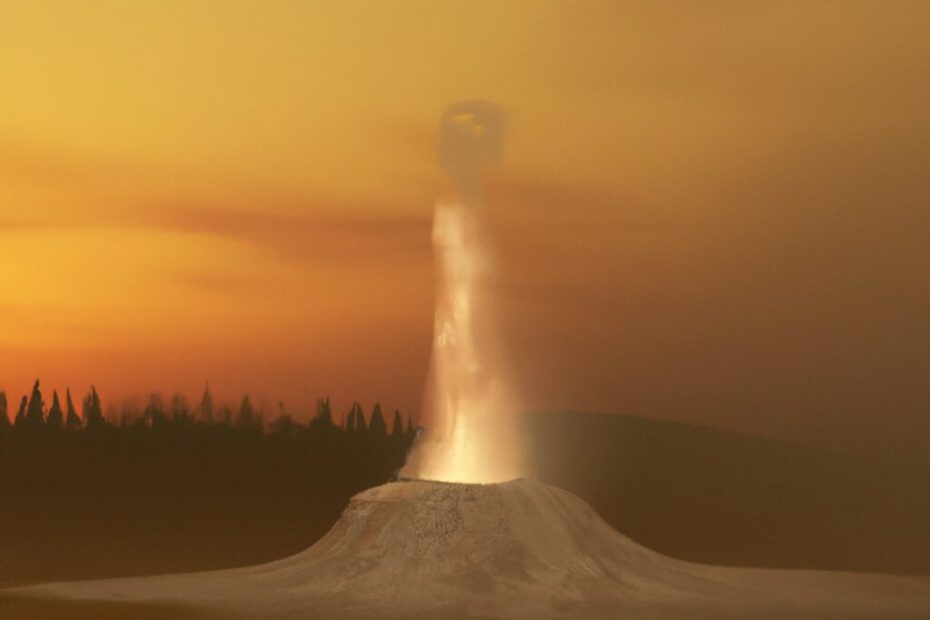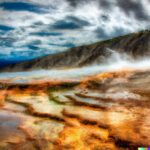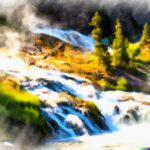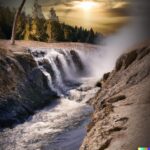Have you ever wondered about the mesmerizing natural phenomena of geysers in Yellowstone National Park? From their intriguing history and discovery to their unique characteristics and impact on the ecosystem, there is so much to learn about these fascinating thermal features.
Join us as we explore the geysers in Yellowstone, including the geological processes behind them, the tourist attractions they offer, and the importance of protecting and preserving them for future generations. Let’s dive into the world of geysers and uncover their secrets together.
What Are Geysers?
Geysers are natural hydrothermal features found in Yellowstone National Park, characterized by the eruption of hot water and steam through vents in the earth’s surface.
They are a remarkable display of the Earth’s geological activity, typically formed when groundwater comes into contact with hot rocks beneath the surface, leading to the buildup of immense pressure. This pressure, combined with the high temperatures resulting from magma chambers deep underground, triggers the explosive release of water and steam.
What makes geysers unique are their intermittent eruptions, with intervals ranging from minutes to days, showcasing the delicate balance between pressure accumulation and release. Yellowstone’s geothermal system, with its myriad geysers and hot springs, stands as a testament to the powerful forces at work beneath the park’s surface.
The History of Geysers in Yellowstone
The history of geysers in Yellowstone is a tale of scientific discovery and exploration, unveiling the park’s natural wonders and unique geological formations through extensive research and study by scientists.
Who Discovered the Geysers in Yellowstone?
The geysers in Yellowstone were discovered by early scientists and explorers fascinated by the park’s natural wonders and unique geological features.
These individuals embarked on expeditions in the late 19th century, documenting their findings and contributing significantly to the initial understanding of geothermal activity in the region.
Notable figures like Ferdinand V. Hayden, who led the first government-sponsored exploration of Yellowstone in 1871, provided detailed descriptions and sketches of the geysers they encountered.
Their precise observations laid the foundation for further research and scientific study, shaping the knowledge base surrounding these hydrothermal phenomena.
When Were the Geysers in Yellowstone Discovered?
The geysers in Yellowstone were officially discovered in the 19th century when geologists and researchers began documenting the unique eruption patterns and hydrothermal activity in the region.
These geothermal wonders first caught the attention of explorers during the Washburn-Langford-Doane Expedition in 1870. The expedition’s members reported spectacular geothermal features, including Old Faithful, which later received its name for its predictable eruptions. Following this expedition, subsequent scientific investigations by the Hayden Geological Survey in the 1870s provided detailed descriptions and measurements of various geysers and hot springs. These early expeditions laid the foundation for the recognition of Yellowstone as the world’s first national park in 1872, primarily due to its remarkable geothermal features.
How Many Geysers Are in Yellowstone?
Yellowstone National Park is home to a remarkable concentration of geysers, with hundreds of these hydrothermal features scattered across the park’s expansive landscape.
These geysers are distributed throughout various regions of the park, from the iconic Old Faithful area to the lesser-known basins like Norris Geyser Basin and Upper Geyser Basin. Each geyser has unique characteristics, such as eruption patterns, temperatures, and mineral compositions, contributing to the diverse landscape of geothermal activity found within Yellowstone.
The significance of these geyser formations goes beyond their visual appeal, playing a crucial role in supporting specialized microbial life and thermal ecosystems within the park, making them vital elements of the Yellowstone ecosystem.
What Makes the Geysers in Yellowstone Unique?
The geysers in Yellowstone stand out for their unique ecosystem, influenced by seismic activity, notable features like the Steamboat Geyser, and ongoing monitoring efforts to study the park’s geothermal features.
This extraordinary ecosystem within Yellowstone not only supports the geysers but also provides a habitat for diverse wildlife species adapted to the extreme conditions. The iconic Steamboat Geyser, known for its unpredictable eruptions and immense water columns, attracts researchers and visitors alike with its awe-inspiring displays.
Continuous monitoring of these geothermal features is crucial for understanding the complex geological processes at play and aiding in predicting potential volcanic activity. Scientists rely on data collected from monitoring equipment to gain insights into Yellowstone’s underground dynamics and volcanic behavior.
How Do Geysers Work?
The operation of geysers is governed by intricate geologic processes that involve the interaction of subsurface water, pressure, and temperature, leading to the periodic eruption of hot water and steam through vents in the earth’s crust.
This remarkable natural phenomenon is primarily driven by the presence of thermal springs beneath the surface. These springs are heated by the earth’s internal heat, causing the water to rise and accumulate in underground chambers. As this water becomes superheated, a critical balance of pressure builds up, ultimately resulting in the spectacular displays of geyser eruptions.
Hydrology plays a crucial role in this dynamic process, with the movement and distribution of water underground shaping the behavior of geysers. Observations of geyser activity, coupled with detailed geologic studies, provide valuable insights into the underlying mechanisms of these captivating geological features.
What Is the Geological Process Behind Geysers?
The geological process behind geysers is a fascinating exploration of how pressure and temperature dynamics interact within the earth’s crust to create the remarkable phenomenon of geyser eruptions.
These geothermal wonders are primarily found in regions with volcanic activity, such as Yellowstone National Park, where a combination of underground water reservoirs and geothermal heat sources contribute to their formation.
The key to geyser eruptions lies in the presence of superheated water trapped in underground chambers, under immense pressure from the weight of overlying rock layers. When this water is heated to its boiling point by the earth’s internal heat, the pressure builds up until it finally bursts through a vent in the earth’s surface, sending a towering column of water and steam into the air.
What Causes the Eruptions of Geysers?
The eruptions of geysers are triggered by the superheating of water beneath the earth’s surface, where interactions with cooling magma, geological activity, and hot springs lead to the explosive release of boiling water and steam through geyser vents.
This superheating process occurs due to the intense heat generated by the Earth’s core, which warms the water trapped in underground reservoirs. The presence of fractures and conduits in the Earth’s crust allows for the buildup of pressure, creating the conditions for geyser eruptions. Subsurface activities such as tectonic movements and volcanic processes can also play a crucial role in triggering these eruptions by affecting the flow and temperature of underground water sources.
The Impact of Geysers on Yellowstone National Park
Geysers play a crucial role in shaping the ecosystem of Yellowstone National Park, influencing groundwater systems, volcanic heat distribution, and conservation efforts to preserve these iconic natural features.
These hydrothermal wonders are not only vital for the ecological balance within the park but also contribute significantly to the geothermal activity that defines Yellowstone’s geological landscape. The intricate network of underground water pathways affected by geysers helps sustain the unique flora and fauna in the area and regulates temperature fluctuations in the region.
Ongoing conservation initiatives are imperative to protect the fragile balance of the geyser ecosystem and ensure the continued enjoyment of these captivating natural phenomena by future generations.
How Do Geysers Affect the Ecosystem?
The interaction of geyser eruption patterns, hydrothermal areas, geological geology, and subsurface water significantly impacts the diverse ecosystem of Yellowstone National Park.
These geyser activities are not just spectacular displays of nature’s power but also crucial elements that shape the landscape and support the rich biodiversity within the park. The eruption patterns influence the distribution of plant species, with certain areas receiving more moisture and nutrients from the geothermal waters.
Hydrothermal zones provide unique habitats for specialized microorganisms that thrive in extreme conditions, playing a vital role in nutrient cycling. The geological structures beneath the surface dictate where hot springs and geysers emerge, creating dynamic landscapes that attract a variety of wildlife. The subsurface water flows connect different ecosystems, facilitating the movement of nutrients and energy throughout the park.
What Are the Tourist Attractions of Geysers in Yellowstone?
The geysers in Yellowstone captivate tourists with their stunning volcanic landscapes, geothermal energy displays, and the mesmerizing spectacle of geothermal features fueled by underground heat sources.
Visitors to Yellowstone National Park are drawn to the vibrant colors and bubbling pools that characterize these unique natural wonders. The thrill of witnessing such powerful displays of nature’s forces, with steam billowing high into the air and water shooting upwards, creates an unforgettable experience. It’s not just about the visual allure; the geysers hold a deeper significance, serving as reminders of the Earth’s immense power and the ongoing geological processes shaping our world. Yellowstone’s geysers truly offer a glimpse into the raw, untamed beauty and energy of the natural world.
The Future of Geysers in Yellowstone
The future of geysers in Yellowstone hinges on ongoing research, exploration of geothermal features, and a deeper understanding of the park’s geologic characteristics through scientific investigations and research findings.
Exploring and studying the intricate geology of Yellowstone National Park plays a pivotal role in not only unlocking the mysteries of its geysers but also in devising strategies for their sustainable conservation.
The continued investment in geothermal exploration and cutting-edge research advancements enables scientists to delve into the underlying mechanisms that drive these natural wonders. By unraveling the complexities of geyser ecosystems, researchers can develop informed management plans that balance preservation efforts with the park’s visitor experience and environmental sustainability goals.
What Threats Do Geysers Face in Yellowstone?
Geysers in Yellowstone are confronted with threats arising from geothermal features, volcanic regions, and the preservation challenges associated with conserving these vital geysers amidst ongoing geothermal heat activities.
The delicate balance between natural processes and human impact plays a crucial role in the sustainability of geysers in Yellowstone. The unique mix of geothermal forces and volcanic influences adds to the complexity of managing these geologic wonders. Efforts are underway to safeguard these fragile ecosystems by implementing conservation strategies that aim to mitigate the risks posed by increasing visitor numbers and potential disruptions to the geothermal systems. The dynamic landscape of the park necessitates continuous monitoring and research to ensure the long-term protection and preservation of these iconic features.
How Can We Protect and Preserve the Geysers in Yellowstone?
Protecting and preserving the geysers in Yellowstone requires a multidisciplinary approach encompassing hydrothermal research, comprehensive geologic studies, an understanding of geothermal origins, and dedicated conservation efforts to safeguard these invaluable natural wonders.
- One key strategy involves conducting ongoing hydrothermal research to monitor the health and behavior of the geysers, allowing for early detection of any potential issues or changes in their activity.
- Geologic investigations can provide valuable insights into the underlying processes that shape these natural features, aiding in the development of effective conservation practices.
- Understanding the geothermal origins of the geysers is crucial in order to implement sustainable management strategies that minimize human impact and protect their fragile ecosystems.
By integrating these principles and initiatives, we can ensure the longevity and sustainability of Yellowstone’s geologic marvels for generations to come.
Last Updated on February 7, 2024 by Jon Waraas – Originally Posted: February 6, 2024

I’m Jon Waraas, and I’ve been navigating the online world since 2006. By day, I’m the proud owner of some eCommerce gems, and by night, I’m the voice behind the adventures on Waraas.Com.
My heart, however, belongs to the wild beauty of Yellowstone National Park. I’ve got a collection of websites dedicated to sharing the wonders of this natural masterpiece. Oh, and did I mention? I’m currently building my own cabin inside the ghost town of Gilmore, Idaho – a cabin with tales to tell!
When I’m not immersed in the digital realm, you’ll find me lacing up my boots for a good hike or setting up camp under the star-studded sky.




